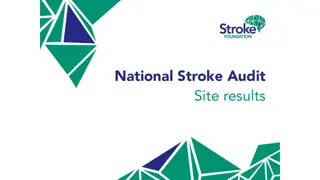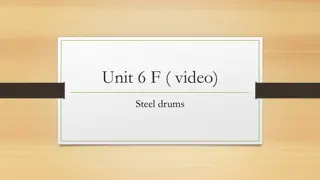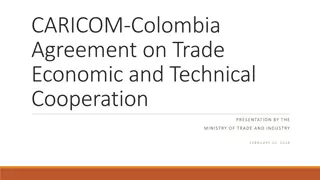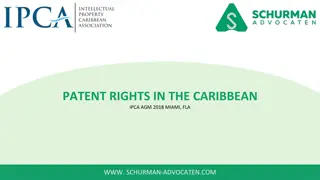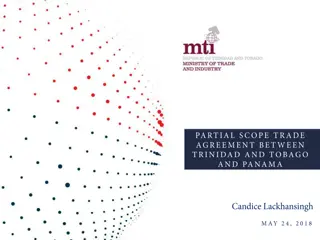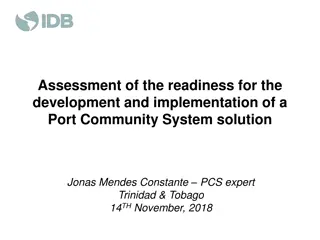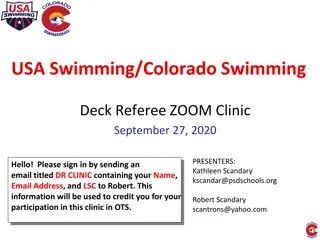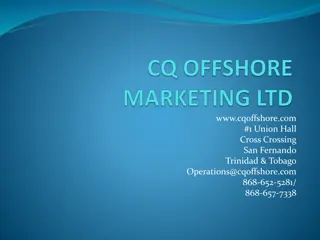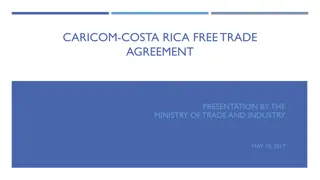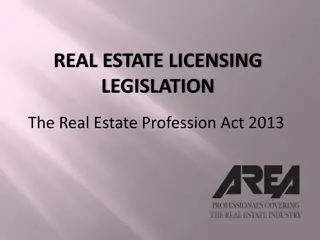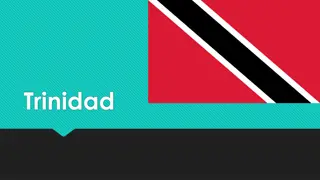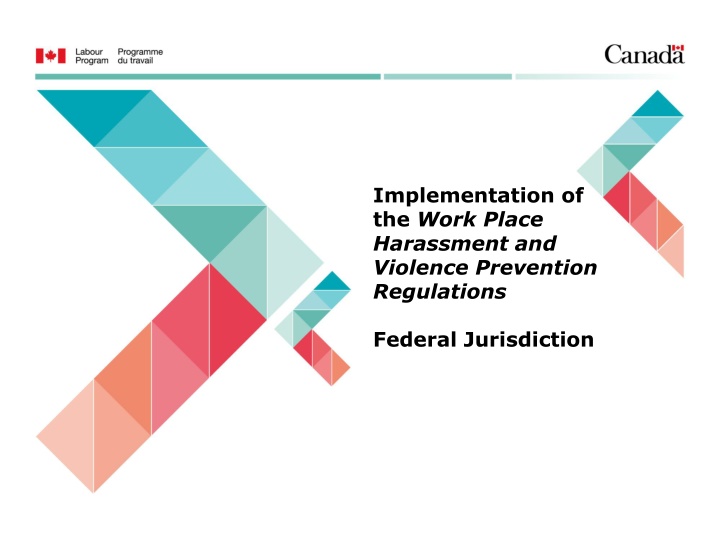
Workplace Harassment and Violence Prevention Regulations in Federal Jurisdiction
Explore the implementation of Workplace Harassment and Violence Prevention Regulations in Federal Jurisdiction, including the establishment of tripartite working groups, development of the Roster of Investigators, interpretation policies, training modules, awareness campaigns, and a prevention hub.
Download Presentation

Please find below an Image/Link to download the presentation.
The content on the website is provided AS IS for your information and personal use only. It may not be sold, licensed, or shared on other websites without obtaining consent from the author. If you encounter any issues during the download, it is possible that the publisher has removed the file from their server.
You are allowed to download the files provided on this website for personal or commercial use, subject to the condition that they are used lawfully. All files are the property of their respective owners.
The content on the website is provided AS IS for your information and personal use only. It may not be sold, licensed, or shared on other websites without obtaining consent from the author.
E N D
Presentation Transcript
Implementation of the Work Place Harassment and Violence Prevention Regulations Federal Jurisdiction
Outline 1. Introduction on Tripartite Working Groups 2. Roster of Investigators Working Group 3. Interpretations, Policies and Guidelines (IPG) Working Group 4. Training Modules for Government of Canada Employees & the Public 5. Awareness Campaigns 6. Technical Briefings, Webcast Event & Podcast 7. Harassment and Violence Prevention Hub 2
Introduction to Tripartite Working Groups The Labour Program (LP) established two tripartite working groups comprised of government, labour and employer representatives in order to jointly develop the Roster of Investigators and the necessary tools and resources, these working groups included the: Roster of Investigators Working Group, which was established in April 2019 to develop the Roster of Investigators; and, IPG Working Group, which was also established in May 2019 to develop an Interpretation, Policies and Guidelines (IPG) guidance document and other tools and resources to assist with interpreting various aspects of the new harassment and violence legislation. The working groups met monthly or biweekly for over the course of 18 months to complete the Roster and the tools and resources. 3
Roster of Investigators Working Group The LP worked with employer and union stakeholders to develop a Roster of Investigators (the Roster) that is hosted in the Canadian Centre of Occupational Health and Safety (CCOHS) website. The purpose of the Roster is to facilitate the engagement of qualified, professional investigators to investigate occurrences of harassment and violence where a notice of an occurrence has been submitted, the resolution process has been initiated and the principal party wishes to proceed with an investigation. The Roster is intended for use only as a list of last resort where: a jointly-developed list of investigators has not been established by the employer and their applicable partner; and, the employer or designated recipient, principal party and responding party are unable to achieve consensus on who should be selected to act as an investigator within 60 days of the employer providing the notice of an investigation. 4
Roster of Investigators Working Group The Working Group designed the criteria and process to screen candidates, launched its first call-out in January 2020, and conducted a final review of the list of candidates. The Roster became available in January 2021 and it has 75 investigators with language profiles in both Official Languages - English and French across 9 provinces and territories. Next call out for additional Roster of Investigators will commence in late 2021 to early 2022. After the second call out the LP is expecting to reach 200 investigators on the Roster. The Roster can be accessed at the following link: https://investigator-enqueteur.ccohs-cchst.ca/#/ 5
Screening Process of Investigators for Rosters First Call out 2020-2021 Pre-screening of candidates Application of exams to assess candidates knowledge of the Canada Labour Code and the Work Place Harassment and Violence Prevention Regulations Assessment of candidates ability to conduct a workplace investigation and produce a written report Two reference checks Second Call-Out 2021-2022 The LP and the Roster of Investigators Working Group are currently discussing the results and lessons learned from the first call-out. New approaches and objectives will also be identified in their meetings. Hence, the selection process and eligibility criteria used in the 2020-21 call out are subject to change. 6
IPG Working Group The LP worked with employer and union stakeholders to develop an Interpretation, Policies and Guidelines (IPG) document and other tools and resources to assist federally regulated employers and employees with interpreting, implementing and applying the new harassment and violence legislation. The purpose of the IPG is to ensure that the new harassment and violence legislation is interpreted consistently and that programs are delivered effectively across the country by Labour Program employees trained in the interpretation of regulatory requirements. The IPG is based on stakeholder needs and feedback, is easily accessible online and is written in plain language. 7
IPG Working Group Contd These tools and resources developed by the IPG Working Group include: an Interpretations, Policies and Guidelines (IPG) document; workplace harassment and violence prevention awareness posters; a sample harassment and violence prevention policy; a policy user guide; a sample work place risk assessment; a list of employer duties; a sample notice of an occurrence template; a sample employer response to a notice of an occurrence template; a sample monthly status update and final monthly status update letter to the principal and responding parties template; steps for employers to resolve a complaint of harassment and violence; and, 8
IPG Working Group Contd steps for employees to submit a complaint of harassment and violence. 9
Training Modules for Government of Canada Employees & the Public The Labour Program worked with the Canadian School of Public Service (CSPS) to develop three online training modules for Government of Canada employees, which were made available in January 2021 to support the implementation of the coming into force of the Bill and Regulations. The training modules included the following online courses: Harassment and Violence Prevention for Employees (W101); Harassment and Violence Prevention for Managers and Committees/Representatives (W102); and, Harassment and Violence Prevention for Designated Recipients and Employers (W103). These were also hosted on the CCOHS website for the broader public to access, they can be accessed at the following link: https://www.ccohs.ca/products/courses/course_listing.html. 10
Awareness Campaign The LP engaged in an extensive awareness campaign to promote the new legislation and the tools and resources developed to support it. The awareness campaign consisted of: 1. Emails to stakeholders (employees, employers and their representatives, and Indigenous communities). Three rounds of emails were sent in 2020 and 2021 to highlight the final publication and coming into force of the Regulations and the new tools and resources that are available online. 2. Social media campaign on Facebook, Twitter and LinkedIn. The campaign ran from June 24 October 29, 2020 to promote the final publication of the new Regulations and from December 29 - February 23, 2021 to promote the coming into force of the new Regulations. 11
Awareness Campaign Contd 3. Awareness posters posted on the Canada.ca website and promoted on social media. The four sample posters can be accessed at the following link: https://www.canada.ca/en/employment-social- development/programs/workplace-health- safety/harassment-violence-prevention/posters.html. 12
Awareness Campaign Contd 4. A series of awareness videos promoted on social media. A video with general information about the Regulations posted on June 26, 2020, which can be accessed at: https://twitter.com/ESDC_GC/status/12765910561931141 13?s=20. A video on civility and respect in the workplace posted several times in 2020, which can be accessed at: https://twitter.com/ESDC_GC/status/13164501223189135 36?s=20. A video on the definition of harassment and violence posed on February 17, 2021, which can be accessed at: https://twitter.com/ESDC_GC/status/13621330780560711 68?s=20. A video about employer requirements under the new Regulations posted on February 25, 2021, which can be accessed at: https://twitter.com/ESDC_GC/status/13649647923945390 22?s=20. 13
Technical Briefings, Webcast Event & Podcast The LP held23technical briefings on the new harassment and violence legislation from July 9 to January 14, 2021 with internal and external stakeholders, including various federal departments and agencies, parliamentary employers, and major employers and unions in the federal sector. On November 16, 2020 the LP participated in the live webcast event hosted by the CSPS. This event was titled Bill C-54 and Its Impact on Workplace Harassment, Violence and Safety and had more than 3000 Government of Canada employees in attendance. In February 2021 the LP recorded a podcast with the CCOHS titled Understanding Canada s New Federal Harassment and Violence Legislation to discuss and unpack the major components of the new legislation. This podcast is hosted on the CCOHS website and can be accessed at the following link: https://www.ccohs.ca/products/podcasts/. 14
Harassment and Violence (H&V) Prevention HUB On July 3, 2018 the LP established a Harassment and Violence Prevention Outreach Hub (the Hub) to support employers and employees in navigating their rights and obligations under the new legal framework. The Hub: includes a 1-800 number and is comprised of 6 Early Resolution Officers (EROs) who have received specific training on helping callers navigate the harassment and violence provisions under the Code and Regulations, identify available educational tools, and direct callers to support services in their regions; EROs particularly focus on supporting employers and employees in their efforts to: prevent incidents of harassment and violence; respond effectively to these incidents whey they occur; and, support victims and employers. 15
H&V HUB Stats The HUB has a service standard objective to return 90% of calls within one business day- between April 2021 and September 2021 (YTD)- it has reached 100% of its target For the previous fiscal year (April 1, 2020 March 31, 2021) HUB EROs received 1279 inquiries. Of these inquiries, 1022 cases were initiated. For the current fiscal year (April 1, 2021- September 2021) HUB EROs received 819 inquiries. Of these inquiries, 673 cases were initiated. Most cases originated from the Ontario region (36%), followed by Quebec (29%), and the Northwest Territories (20%). Cases by industry breakdown shows that most cases were initiated in the road transport trucking sector (17%), followed by Frist Nations (12%), the Federal Public Service (10%), Air Transport (5%), and Postal Service (5%). Since 2018 and up to October 29, 2021, HUB EROs have spent over 3757 hours counselling clients on the former Part XX Violence in the Workplace Regulations and 1131 hours on the new legislation. 16



